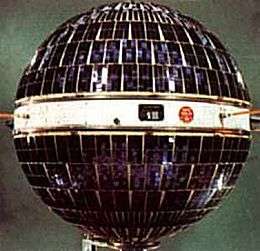Courier 1B
 Courier 1 satellite | |
| Mission type | Communication |
|---|---|
| Operator | United States Air Force |
| COSPAR ID | 1960-013A |
| SATCAT no. |
00058 |
| Mission duration | 17 days (achieved) |
| Spacecraft properties | |
| Launch mass | 230 kilograms (510 lb) |
| Start of mission | |
| Launch date | 4 October 1960, 17:50 UTC |
| Rocket | Thor DM-21 Ablestar |
| Launch site | Cape Canaveral LC-17B |
| Orbital parameters | |
| Reference system | Geocentric |
| Regime | Low Earth |
| Eccentricity | 0.02001 |
| Perigee | 938 kilometres (583 mi) |
| Apogee | 1,237 kilometres (769 mi) |
| Inclination | 28.33 degrees |
| Period | 106.8 minutes |
| Epoch | 4 October 1960 13:45:00 UTC [1] |
Courier 1B, the world's first active repeater communications satellite, was successfully launched October 4, 1960 at 1:50 PM from Cape Canaveral, Florida. The first Courier satellite in Project Courier, Courier 1A, was lost 2.5 minutes after lift-off on August 18, 1960.
As a Cold War initiative, Courier 1B was the 26th satellite launched by the US as opposed to the Soviet Union's six satellites since Sputnik I in 1957. Proposed by the US Army Signal Corps in September, 1958, Courier 1B was a follow up to Project SCORE launched December 18, 1958. SCORE "was the first step of an evolutionary program to develop communication satellite systems for use by the military services" [2] Project Courier was a joint program of the US Department of Defense Advanced Research Projects Agency (ARPA) along with the US Army Signal Research & Development Laboratory at Fort Monmouth, New Jersey.
Basically, Courier 1B would receive messages or photographs, store them, and then re-transmit them. Courier 1B was:
an experimental system to demonstrate the feasibility of using satellites for providing a solution to global communications problems. It was designed to store teletype messages and transmit them at high speed while the satellite is in view of a ground station ... orbiting Earth at 690 miles.[3]
Courier 1B had an effective message transmission rate of 55,000 bits per second and :
used ultra–high frequency (UHF) communications. This portion of the electromagnetic spectrum had remained relatively unused and generally free from man-made and atmospheric interference. The Courier satellite could simultaneously transmit and receive approximately 68,000 words per minute while moving through space at 16,000 miles per hour, and could send and receive facsimile photographs[4]
After completing a first orbit, a teletype message to the United Nations General Assembly from US President Dwight D. Eisenhower was sent to US Secretary of State Christian Herter, to be delivered by Herter to Frederick H Boland, President of the General Assembly at the United Nations then in session in New York. Eisenhower's message was transmitted by Courier 1B from the Camp Evans, Deal Test Site, a New Jersey off-base transmission facility of Fort Monmouth. The message was relayed to the Camp Salinas Training Area, a ground station and tracking installation in Salinas, Puerto Rico. If Courier 1B was in sight of the two ground stations at the same time, Courier 1B had the capability of "real time" messaging.[5]
After 228 orbits over 17 days, the payload failed to respond to commands. It was believed that the clock-based access codes got out of synchronization and the satellite would not respond to what it interpreted as unauthorized commands.
Courier 1B was built by the Western Development Labs (WDL) division of Philco, previously known as "Army Fort Monmouth Laboratories" and now the Space Systems/Loral division of Loral Space & Communications. IT&T provided ground support equipment and Radiation, Inc, Melbourne, Florida, made the large dish ground antennas. Sonotone Corporation, Elmsford, New York developed the on-board power system for the satellite. Courier used approximately 19,000 solar cells and was the first satellite to use nickel–cadmium storage batteries.
See below bibliography, footnotes, and links for further information on Project Courier.
Further reading
- James E. Bartow, Thomas P. Mottley, Walter P. Teetsel, "The Courier Communications Satellite System". In Telecommunication Satellites (Theory, Practice, Ground Stations, Satellites, Economics), edited by K.W. Gatland. 156-183.
- T.P. Mottley, D.H. Marx, W.P. Teetsel, "A Delayed-Repeater Satellite Communication System of Advanced Design". In IRE Transactions on Military Electronics, Vol. MIL-4, No. 2, April-July 1960, 195-207. N.B.: IRE Transactions on Military Electronics is currently published as IEEE Transactions on Aerospace and Electronic Systems.
- Pierce W. Siglin & George Senn, "Courier Communication Satellite". In The Journal of the Institution of Electrical Engineers, Vol. 7, August 1961, 504-508.
- G.F. Senn & P.W. Siglin, "Courier Satellite Communication System". In IRE Transactions on Military Electronics, Vol. MIL-4, No.4, October 1960, 407-413. N.B.: IRE Transactions on Military Electronics is currently published as IEEE Transactions on Aerospace and Electronic Systems.
See also
References
- ↑ "NASA - NSSDCA - Spacecraft - Details". nssdc.gsfc.nasa.gov. Retrieved 2018-04-30.
- ↑ T.P. Mottley, D.H. Marx, W.P. Teetsel, " A Delayed - Repeater Satellite Communication System of Advanced Design", IRE Transactions on Military Electronics,Vol. MIL-4, No. 2, April-July 1960. 195.
- ↑ Bartow, James E., Mottley, Thomas P., Teetsel, Walter P. “The Courier Communications System.” In Telecommunication Satellites, edited by K.W. Gatland (London: Illife Books LTD., 1964), 156.
- ↑ Raines, Rebecca Robbins (1996). Getting the Message Through A Branch History of the US Army Signal Corps (PDF). Washington, DC: Center of Military History, US Army. p. 332.
- ↑ Bartow, Mottley, Teetsel . “The Courier Communications System.” In Telecommunication Satellites, 157.